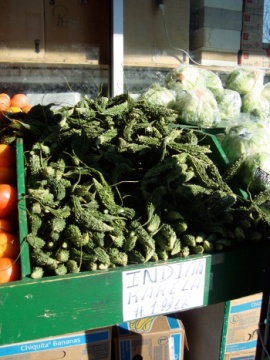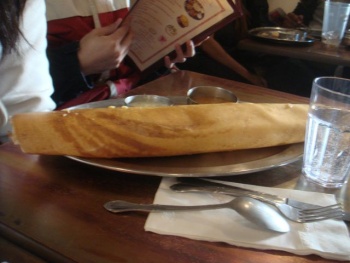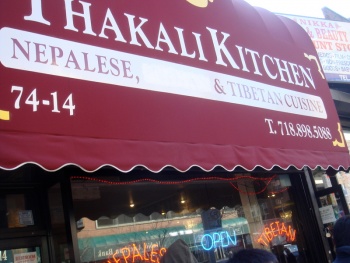From The Peopling of New York City
Introduction
One of the most striking aspects of the Jackson Heights South Asian business district is the large number of restaurants and food shops in a small area. Established restaurants, curbside halal food carts, groceries and sweets shops flourish in a relatively small area. The issue raised here is the multiple meanings of food for the immigrants who patronize these establishments, whether for a weekend family feast, for a night out with friends, or for a quick inexpensive lunch. The importance of home cooking can be understood by looking at the housewives and families who flock into the two large grocery stores in the area to buy ingredients—spices, oils, grains and vegetables—that are particularly South Asian and rarely found in ordinary American supermarkets.
Jackson Heights is—paradoxically—a South Asian business district where restaurants selling many other kinds of foods can also be found. In addition to the expected Indian food, Japanese, Nepalese, Tibetan, Malaysian, Korean, and Chinese food is also offered by the individual restaurants in the area. These restaurants represent more than just a business. Each presents a particular ethnicity through the ingredients, preparation, presentation, and the etiquette by which the dishes are eaten. The restaurants in this area feature the originality of homeland dish and preserve it, despite the translocation to New York City. Area restaurants maintain, for instance, a particular distinction between North Indian restaurants offering “mogul style” food featuring grilled meats and cream sauces, and South Indian restaurants which emphasize spicier vegetarian food and in particular the snack called “dosai"—a filled crepe.
If we look at the restaurants in Jackson Heights we see that they have to do more than offer food to hungry diners. They also have to take into account increasingly adventurous tastes among some diners, while avoiding offence to the religious beliefs of other patrons. They need to advertise their particular ethnicity while providing food that is not utterly unfamiliar to the area’s customers.
Presentation of Ethnicity Through Food
Unique Preparation to Represent Ethnicity
An important part of the ethnic identity presented by food is the means by which a dish is prepared. Just as Chinese restaurants prepare their foods with the wok, the ethnic foods found in Jackson Heights follow conventions that make a dish authentic. One example of such preparation is seen in the restaurants and carts that prepare halal foods. Before a halal dish can be prepared, the ingredients must be deemed permissible by Islamic law. In this procedure, meat,for example must be ritually slaughtered following the method of Dhabīḥah. Every halal dish conforms to these standards and shows how the Islamic ethnicity can be revealed through the dishes preparation.
Use of Specific Ingredients to Represent Ethnicity
| Ethnicity | Distinguished Component |
|---|---|
| Japanese | onions, carrots, potatoes, meat, commercial curry powder |
| Malaysian | Turmeric, coconuts milk, shallots, ginger, chili, garlic, commercial curry powder |
| Chinese | Green peppers, chicken, potatoes, hot chili oil, commercial curry powder |
| Thai | Chili peppers, kaffir lime leaves |
| Indian (Malayali) | Coconut milk, coconut pieces, mustard seeds, chili, fish or vegetables |
| Indian (Bengali) | Seafoods, mustard seeds, poppy seeds |
| Indian (Punjabi) | Butter and cream, individual spices, chicken or lamb |
The ingredients of a dish play a major role in representation of an ethnic identity. Unique blends and proportions of the ingredients change not only the taste of the dish but the ethnicity that the dish represents. For example many cuisines today offer a dish called “curry,” a term and a taste which originated in India. Today the composition of each area’s curry is unique. This chart, compiled from recipes found through online food sites, suggests the range of variation. Properly made Indian curries use different spice-herb mixtures for each meat or vegetable, while the Chinese and Southeast Asian curries rely on commercial curry powder. Whether it be Japanese curry or Indian curry, or Malaysian curry, each unique curry differentiates one ethnic group from another.
The Way Food is Consumed
Once a food is prepared, the etiquette by which a dish is eaten also presents an ethnic identity. When eating a dish like “dosa”, a crepe made from rice and black lentils, it can clearly be seen that the exotic shape of the dish calls for an alternative means of consumption. Instead of forks and knives, the fingers are used to scoop the dish into the mouth. In fact, eating with the fingers instead of with forks and knives is a major feature of Indian ethnic identity, but there is further differentiation within India. For example, the North Indian etiquette forbids the patron from having the more than the fingertips stained as compared to South Indian etiquette that allows the food to touch fingers and palms while eating. By analyzing how a dish is consumed at the table, an ethnic identity can be identified.
The Presentation of Food
One of the major ways “ethnic” restaurants signal their particular brand of ethnicity to customers is through music, decor and the way dishes are presented. Restaurants in Jackson Heights such as “The Dosa Place” and “Thakali Kitchen” hire live bands to entertain guests while expressing the identity of the food. Music from regions is distinct in style and allows guests to correlate such ethnic music to the dish. In addition, the visual presentation of a dish also connects it to the ethnicity of the food. For example, serving a dish on a banana leaf is a common practice for South Indians. Restaurants here in Jackson Heights however may not have the access the leaf but one may speculate that they emulate this with the presentation of large flat plates. Many Indian restaurants signal their Indian-ness by serving food in little dishes arranged around a large flat plate called a thali. The diner mixes the contents of little dishes to taste with rice or flat bread at the center of the plate.
Food Means More Than Taste
Eating patterns can also signal the personal religious beliefs of the diner. Many Indian Hindus and Jains, along with Asian Buddhists, are committed vegetarians on moral grounds. Others will eat meat but avoid beef and pork. In contrast Muslims, whether from Pakistan, Bangladesh or India, will refuse to eat pork, and prefer that other meat be halal. All eating establishments catering to South Asian customers have to accommodate these beliefs by offering vegetarian dishes, avoiding meat or fish stocks in vegetarian dishes, keeping pork off the menu, even in Chinese restaurants, and labeling the meat dishes halal. Shruti Vyas[3], an Indian-American girl interviewed, indicated the strength of these moral beliefs attached to food: “Being a vegetarian is something I strongly believe in. By hurting and killing animals, you are destroying a soul.”
Preservation of Ethnicity Through Food
A Focus on One Cuisine
Restaurants preserve the ethnicity of a food by concentrating their resources on one ethnic cuisine. Though the community of Jackson Heights is very diverse, restaurants make the active decision to specialize instead of competing against others. In the Thakali Kitchen, the owner[4] dropped the Indian cuisine from his menu. He says “There are a lot of other Indian restaurants and so we really wanted to concentrate more on Nepalese and Tibetan dishes.” Thakali Kitchen is only one of many that specializes its cuisine. Jeremy Saunders[5], owner of the Japanese restaurant Happy Kitchen says “There are differences, and when you start to mix them all, usually, one type is better than the other, and one type is not as good as it could be.” Through this active mindset in preserving the taste, the ethnic aspects of the foods are preserved.
Using Family to Achieve Authenticity
Restaurants in Jackson Heights also preserve ethnicity by calling upon family members to make the meals or by hiring ethnically compatible workers. In Thakali Kitchen for example, the owner’s aunt takes care of the cooking. Similarly Jeremy Saunders’ Japanese wife takes care of the hiring workers and Khan Baba Buffet Restaurant also features a family of workers who prepare the dishes. In preserving ethnicity of the food, it is also essential to preserve the ethnicity of the workers who cook the dish. When there is a connection to the homeland country from which the dish originates from, there is a greater authenticity to the cuisine.
Changing Market But Same Style
In the diverse neighborhood of Jackson Heights, restaurants face a constantly diversifying community. In response to this change, Restaurants have changed their menus but they always keep the style of the dish. At the Delhi Palace Restaurant, worker Eugene D'Costa[6] said “Yes, we’ve added many different kinds of foods and taken away many. When people change, we have to find out what foods they like and what they don’t.” In order to satisfy the customers, the Delhi Palace Restaurant has changed their menu, but has maintained its popular Indian dishes for over 30 years. This consistency reflects the community’s identity, but it is not the only restaurant to do so.
“While we will adapt things we are careful to keep them authentic.” – Jeremy Saunders
“We wont compromise it” - Kamini Vadhan
“We haven’t changed a bit.” – Owner at Thakali Kitchen
Nothing Is Like Quite Like Home
Although it might seem that the Jackson Heights shopping area offers anything South Asian a diner or home cook might want, many South Asians retain a lurking feeling that the true tastes of home are unobtainable here. Kanushree Jain[7], a student in college says, “For the most part Indian food here tastes like Indian food in India. However, if we were living in India we would get fresher produce. In India, no preservatives or harmful agents are added to the fresh foods. So you can say that the taste differs in the type of produce that the dishes are made from.” Not only is there a loss of freshness, there also arises the new problem of finding spices. The Patel Brothers Supermarket attempts to ease this problem with the specialized Spice section but there are still losses of specialized products that can only be found in India.
Changes To Come
In spite of the self-identified South Asian area, Jackson Heights is rapidly adjusting in diversity. With a greater number of Bangladesh and Tibetans coming into the neighborhood, the food’s market is changing as newer generations of immigrants arrive. This newer generation is more open to a variety of foods and open themselves to dishes outside of their ethnic norm. Restaurants owners see these changes in the community and reflect their cuisines on them. Jeremy Saunders says “. Usually it’s not the first generation Indian who orders our curry because its not what they are accustomed to. It’s the second generation, their children will come in and order it because it’s softer, its on the pallet, its different.” The owner in Thakali Kitchen said “We have fewer Indian people. Many have moved to Long Island or New Jersey. Out here they’ve done enough. Right now, it’s becoming less Indian and more Bangladesh and other people.” With a new market, questions arise on how the existing business will support the new ethnic groups. How an existing established market will change still needs to be seen in the neighborhood.



